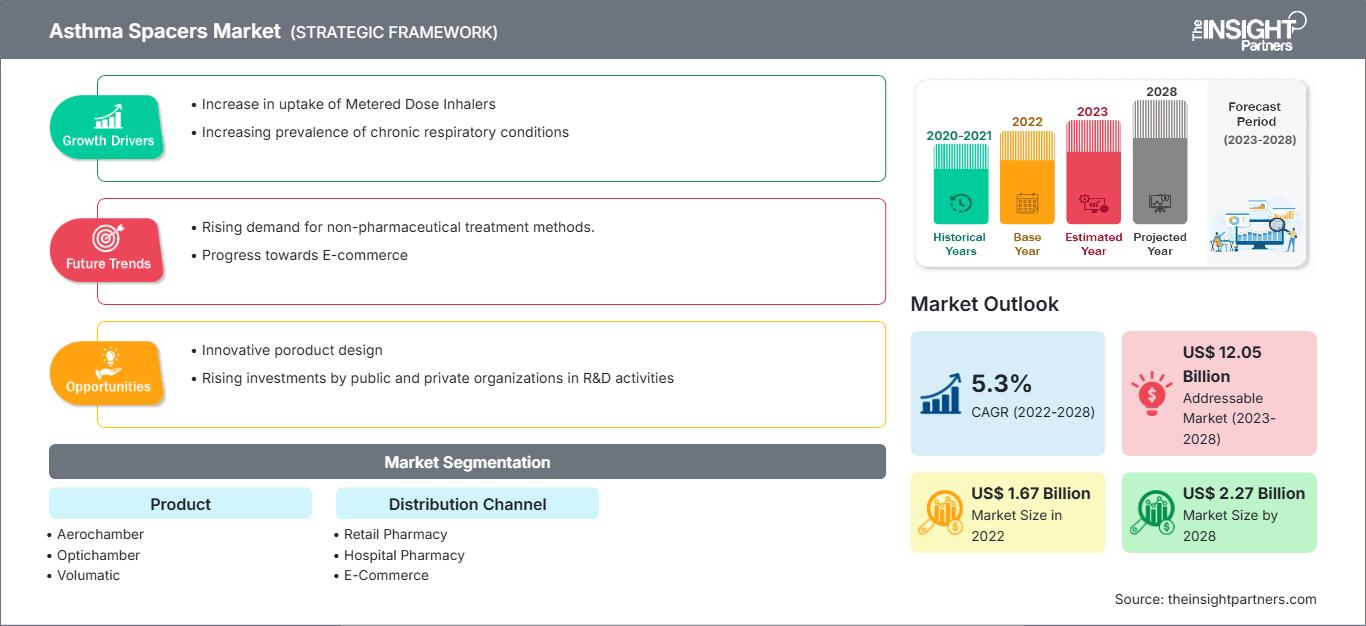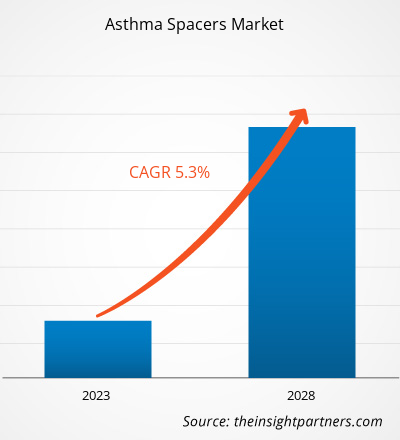Si prevede che il mercato dei distanziatori per l'asma crescerà da 1.666,48 milioni di dollari nel 2022 a 2.266,47 milioni di dollari entro il 2028; si stima una crescita a un CAGR del 5,3% dal 2022 al 2028.
I distanziatori per l'asma sono dispositivi esterni che migliorano la somministrazione del farmaco aumentando l'inalazione e l'erogazione. I distanziatori aiutano a somministrare la giusta quantità di farmaco ai polmoni se utilizzati insieme all'inalatore dosato (MDI). L'applicazione del distanziatore per l'asma contribuisce a ridurre lo spreco di farmaco e limita anche il verificarsi di eventi avversi associati alla dose. L'asma è una malattia respiratoria cronica che colpisce le vie aeree polmonari con sintomi variabili e ricorrenti come costrizione toracica, mancanza di respiro, respiro sibilante e tosse. Nella maggior parte dei casi, è molto difficile distinguere l'asma dalla BPCO nei pazienti anziani a causa di caratteristiche cliniche simili, mentre la recidiva dell'asma rappresenta un problema importante nei pazienti più giovani. I fattori genetici influenzano fortemente lo sviluppo della malattia.
La crescita del mercato dei distanziatori per l'asma è attribuita alla crescente prevalenza di patologie respiratorie croniche, alla crescente consapevolezza dei benefici dei distanziatori e ai crescenti investimenti da parte di organizzazioni pubbliche e private in attività di ricerca e sviluppo per l'innovazione di prodotto. Tuttavia, l'aumento dei costi di questi dispositivi e la scarsa conoscenza del prodotto da parte del pubblico ne stanno frenando la crescita del mercato.
Personalizza questo rapporto in base alle tue esigenze
Potrai personalizzare gratuitamente qualsiasi rapporto, comprese parti di questo rapporto, o analisi a livello di paese, pacchetto dati Excel, oltre a usufruire di grandi offerte e sconti per start-up e università
Mercato dei distanziatori per l'asma: Approfondimenti strategici

- Ottieni le principali tendenze chiave del mercato di questo rapporto.Questo campione GRATUITO includerà l'analisi dei dati, che vanno dalle tendenze di mercato alle stime e alle previsioni.
Potrai personalizzare gratuitamente qualsiasi rapporto, comprese parti di questo rapporto, o analisi a livello di paese, pacchetto dati Excel, oltre a usufruire di grandi offerte e sconti per start-up e università
Mercato dei distanziatori per l'asma: Approfondimenti strategici

- Ottieni le principali tendenze chiave del mercato di questo rapporto.Questo campione GRATUITO includerà l'analisi dei dati, che vanno dalle tendenze di mercato alle stime e alle previsioni.
Il mercato dei distanziatori per l'asma è segmentato in base a prodotto, canale di distribuzione e area geografica. In base all'area geografica, il mercato dei distanziatori per l'asma è ampiamente segmentato in Nord America, Europa, Asia-Pacifico, Medio Oriente e Africa e America meridionale e centrale. Il rapporto sul mercato dei distanziatori per l'asma offre approfondimenti e analisi approfondite del mercato, evidenziando parametri quali dimensioni del mercato, tendenze, progressi tecnologici e dinamiche di mercato. Il rapporto include anche l'analisi del panorama competitivo dei principali attori del mercato mondiale dei distanziatori per l'asma. Inoltre, il rapporto include l'impatto della pandemia di COVID-19 sul mercato dei distanziatori per l'asma in tutte le regioni.
Approfondimenti di mercato: Aumento della domanda dovuto alla crescente diffusione degli inalatori dosati
La crescente prevalenza di patologie respiratorie, come asma e BPCO, crea opportunità redditizie per l'adozione di inalatori dosati. Ad esempio, secondo uno studio pubblicato da un gruppo di ricercatori del Dipartimento di Medicina Polmonare e Terapia Intensiva della Mayo Clinic, nel 2020 si prevede che il numero di casi di asma raggiungerà quasi il 52,0% nei prossimi 20 anni negli Stati Uniti. Inoltre, secondo lo stesso studio, si prevede che la spesa per il trattamento dell'asma negli Stati Uniti raggiungerà i 963 miliardi di dollari entro il 2038, il che favorirà la crescita dell'utilizzo di inalatori dosati, accelerando infine l'adozione di inalatori e distanziatori durante il periodo di previsione. Parallelamente, anche i casi di asma in Europa sono in costante aumento. Inoltre, oltre 30 milioni di bambini e adulti di età inferiore ai 45 anni convivono attualmente con l'asma in Europa, secondo i dati del Libro Bianco Polmonare Europeo. Tra tutti i paesi europei, Regno Unito, Spagna e Irlanda presentano alcuni dei tassi di asma più elevati. Inoltre, le autorità governative e le istituzioni sanitarie stanno implementando vari programmi per aumentare la consapevolezza sull'asma e prevenire la morbilità dovuta a questa malattia. Il National Asthma Control Program (NACP), lanciato dai Centers for Disease Control and Prevention (Centri per il Controllo e la Prevenzione delle Malattie), lavora costantemente per aumentare la consapevolezza sull'asma e arginare la malattia. Tali programmi stanno promuovendo l'adozione di inalatori, che a loro volta stanno trainando il mercato.
I distanziatori svolgono un ruolo fondamentale nella somministrazione di farmaci alle vie respiratorie. Tuttavia, in alcuni casi, i pazienti incontrano difficoltà nell'utilizzo del distanziatore a causa delle sue dimensioni e del suo design. Ad esempio, secondo uno studio condotto da Trudell Medical, uno dei principali attori del mercato nel 2019, la maggior parte dei pazienti si sente in imbarazzo a utilizzare i distanziatori a causa delle loro dimensioni e del loro design. Per far fronte a questo problema, gli operatori del settore si stanno ora concentrando sugli aspetti progettuali, che saranno facili da trasportare e offriranno un trattamento efficace per le patologie respiratorie. Pertanto, nuovi design e funzionalità migliorate stanno rimodellando il mercato statunitense dei distanziatori per l'asma.
Approfondimenti basati sul prodotto
In base al prodotto, il mercato dei distanziatori per l'asma è segmentato in Aerochamber, Optichamber, Volumatic e Inspirease. Nel 2022, si prevede che Aerochamber deterrà la quota di mercato maggiore e che registrerà il CAGR più elevato dal 2022 al 2028.
Approfondimenti regionali sul mercato dei distanziatori per l'asma
Le tendenze regionali e i fattori che influenzano il mercato dei distanziatori per l'asma durante il periodo di previsione sono stati ampiamente spiegati dagli analisti di The Insight Partners. Questa sezione illustra anche i segmenti e la geografia del mercato dei distanziatori per l'asma in Nord America, Europa, Asia-Pacifico, Medio Oriente e Africa, America Meridionale e Centrale.
Ambito del rapporto di mercato sui distanziatori per l'asma
| Attributo del rapporto | Dettagli |
|---|---|
| Dimensioni del mercato in 2022 | US$ 1.67 Billion |
| Dimensioni del mercato per 2028 | US$ 2.27 Billion |
| CAGR globale (2022 - 2028) | 5.3% |
| Dati storici | 2020-2021 |
| Periodo di previsione | 2023-2028 |
| Segmenti coperti |
By Prodotto
|
| Regioni e paesi coperti | Nord America
|
| Leader di mercato e profili aziendali chiave |
|
Densità degli operatori del mercato degli spaziatori per l'asma: comprendere il suo impatto sulle dinamiche aziendali
Il mercato dei distanziatori per l'asma è in rapida crescita, trainato dalla crescente domanda da parte degli utenti finali, dovuta a fattori quali l'evoluzione delle preferenze dei consumatori, i progressi tecnologici e una maggiore consapevolezza dei benefici del prodotto. Con l'aumento della domanda, le aziende stanno ampliando la propria offerta, innovando per soddisfare le esigenze dei consumatori e sfruttando le tendenze emergenti, alimentando ulteriormente la crescita del mercato.

- Ottieni il Mercato dei distanziatori per l'asma Panoramica dei principali attori chiave
Approfondimenti basati sul canale di distribuzione
In base al canale di distribuzione, il mercato dei distanziatori per l'asma è segmentato in farmacie al dettaglio, farmacie ospedaliere ed e-commerce. Nel 2021, il segmento delle farmacie al dettaglio ha detenuto la quota di mercato maggiore e si prevede che registrerà il CAGR più elevato dal 2022 al 2028.
Il lancio e l'approvazione dei prodotti sono strategie comunemente adottate dalle aziende per espandere la propria presenza globale e il proprio portafoglio prodotti. Inoltre, gli operatori del mercato dei distanziatori per l'asma si concentrano sulla strategia di partnership per ampliare la propria clientela, il che, a sua volta, consente loro di mantenere il proprio marchio a livello globale. Si prevede che il mercato prospererà nei prossimi anni grazie allo sviluppo di prodotti innovativi da parte degli operatori del mercato.
Profili aziendali:
Cipla Inc., PARI GmbH, Koninklijke Philips NV, Lupin, HAAG-STREIT GROUP, Laboratoire ProtecSom, Monaghan Medical Corporation, Koo Medical Equipment, Agaplastic, Metall Zug e Teleflex Incorporated sono tra le aziende leader che operano nel mercato globale dei distanziatori per l'asma.
- Analisi storica (2 anni), anno base, previsione (7 anni) con CAGR
- Analisi PEST e SWOT
- Valore/volume delle dimensioni del mercato - Globale, Regionale, Nazionale
- Industria e panorama competitivo
- Set di dati Excel
Report recenti
Testimonianze
Motivo dell'acquisto
- Processo decisionale informato
- Comprensione delle dinamiche di mercato
- Analisi competitiva
- Analisi dei clienti
- Previsioni di mercato
- Mitigazione del rischio
- Pianificazione strategica
- Giustificazione degli investimenti
- Identificazione dei mercati emergenti
- Miglioramento delle strategie di marketing
- Aumento dell'efficienza operativa
- Allineamento alle tendenze normative






















 Ottieni un campione gratuito per - Mercato dei distanziatori per l'asma
Ottieni un campione gratuito per - Mercato dei distanziatori per l'asma